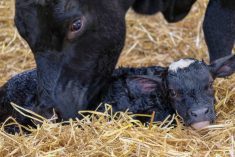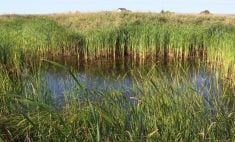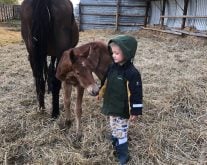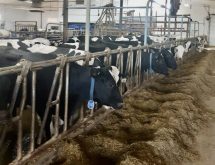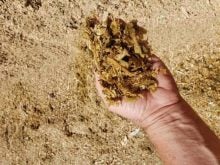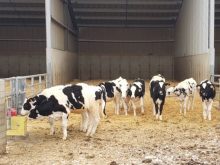High-quality alfalfa has not escaped the high cost of other dairy feeds, and thus significantly contributes to the record-setting cost of producing milk.
And last year’s foul growing season, with wet conditions in some areas across the Prairies, was not kind to some alfalfa crops, resulting in some sprouting. This resulted in a few cases of a buildup of dangerous alfalfa nitrates. Despite the potential risk, producers should plan to feed high-quality and low-nitrate alfalfa to promote high performance in their lactating dairy cows. If there is any concern about nitrate levels, feed should be tested.
As a dairy nutritionist, I think of alfalfa primarily as a high-protein forage for lactating dairy cows. On a pure alfalfa strand, its crude protein (CP) normally ranges from 18-25 per cent on a dry matter basis as well as a soluble protein fraction (loosely defined as available protein that is soluble in rumen fluid) of 40-50 per cent of CP in alfalfa samples that I have reviewed. I would rather add a little more home-grown alfalfa hay or haylage, when I have the dietary room in a lactation diet, than add purchased proteins such as soybean or canola meal.
Read Also

Harvest wraps up and fall work begins
At the Eppich famly ranch in western Saskatchewan, the fall harvest was successful with few breakdowns, cows and calves have been sorted and a new tractor has arrived
Aside from its good protein content, high-quality alfalfa is a significant energy source for high-performing dairy cows. For example, the net energy of lactation estimated for alfalfa hay with a modest feed value (RFV) of 150 is around 1.35 Mcal/kg compared to 1.50 Mcal/kg estimated energy for typical corn silage.
Some of this dietary energy comes from alfalfa’s relatively high non-fibre carbohydrate content (NFC), which is between 25-30 per cent on a dry matter basis and consisting mainly of highly digestible pectin (12-13 per cent), starch (two to three per cent) and nominal sugar. The remainder is locked away in its structural fibre (35-40 per cent), which is released during microbial fermentation in the cow’s rumen and rounds out alfalfa’s total energy value, and provides substantial amounts of effective forage fibre requirements (eNDF).
Alfalfa fibre digestion in the lactating dairy cows is rather a nutritional puzzle. The fibre consumed and energy released/contributing toward milk production is done rather quickly (alfalfa’s lower hemicellulose fibre content means more rapid rate of overall fibre digestion), but might be limited due to its high woody lignin fibre. Therefore, when dairy cows are fed a well-balanced diet with a high-quality alfalfa level there is often enhanced forage digestibility and a quicker rate of passage through the cow, which leads to greater dry matter (dm) feed/essential energy and protein intake that should result in better milk production.
Don’t know will you try
For instance, I recently substituted 2.0 kg of good-quality second-cut alfalfa hay and dialled back on an equal amount of corn silage on a dry matter basis in a lactation diet for a 150-cow dairy.
I intended to raise the overall dietary crude protein of the diet from 15.0 to 16.5 per cent. Corn distillers grains was added to offset the high levels of alfalfa soluble proteins. The final diet maintained at least 28 per cent NDF, with 75 per cent of this NDF coming from forage sources.
As a result, the milk cows had looser manure, while dry matter intake increased by 0.5 kg per head, daily. Milk production went from 37.5 to 38.3 kg on a daily pickup, and yet its milkfat content dropped 0.2 per cent. Rather, than add 150 gram of palm fat to shore up this loss of milkfat, the producer and I decided to go back to the previous dairy TMR for the time being.
This alfalfa hay formulated in this lactation diet was harvested last year under excessive moisture conditions, which made it susceptible to accumulating nitrates. Alfalfa samples were tested and fortunately, came back negative for nitrates. Dairy cattle can safely consume a diet containing nitrates that are below 0.5 per cent nitrate (NO3) or below 0.12 per cent nitrate nitrogen (NO3N) on a dry matter basis.
Many people were not so lucky and ended up with feed with higher nitrates, yet safely fed their high-nitrate alfalfa by mixing it with other low-nitrate forages and grains. As a result, the mixture contained a nitrate level below critical limitation.
I view low-nitrate, high-quality alfalfa as an integral part of a balanced lactation dairy diets, because it provides a lot of essential nutrients to promote good milk performance. It is important to test feeds to ensure they can be included safely at the proper level in a well-balanced ration.




